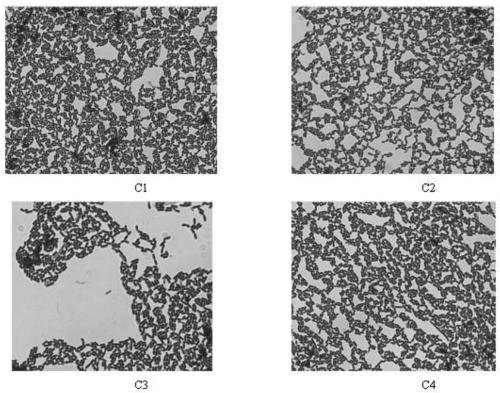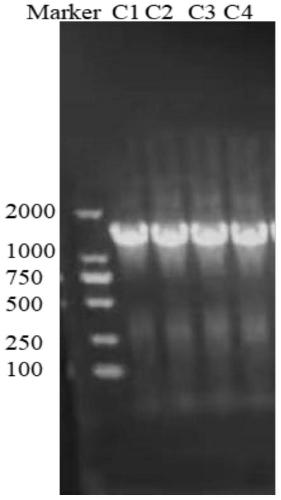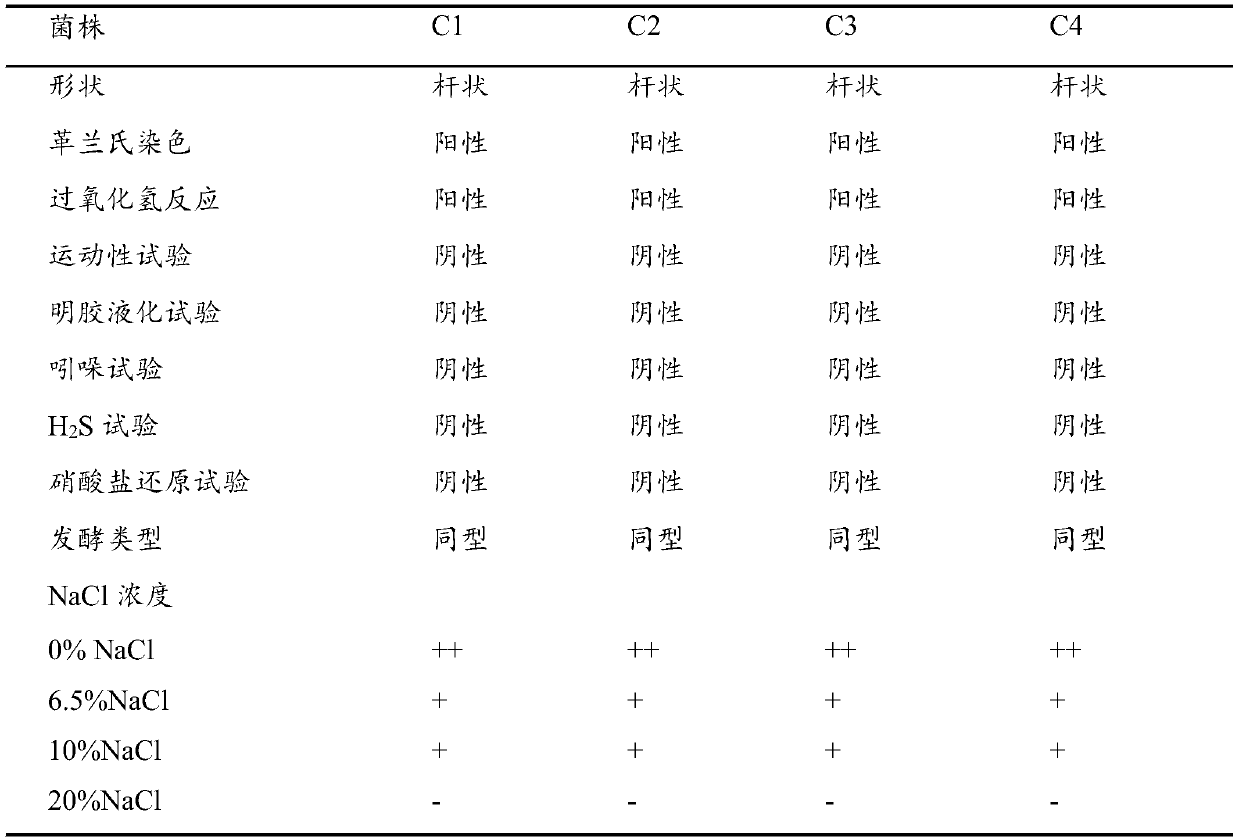Salt-tolerant lactobacillus plantarum C4 and application thereof
A technology of Lactobacillus plantarum and salt tolerance, applied in the field of microorganisms, can solve problems such as poor salt tolerance of lactic acid bacteria strains, achieve the effect of improving rumen degradation rate and fermentation quality
- Summary
- Abstract
- Description
- Claims
- Application Information
AI Technical Summary
Problems solved by technology
Method used
Image
Examples
Embodiment 1
[0025] MRS agar medium (MRS agar medium, MRS) was used for plate culture. According to the morphology of the colony, 42 strains of suspected lactic acid bacteria were picked out. These strains were purified and identified as lactic acid bacteria. MRS liquid and solid medium (pH6.5) with concentrations of 0%, 6.5%, 10% and 20% NaCl were prepared for screening of salt-tolerant lactic acid bacteria.
[0026] Specifically: the isolated 42 strains were positive for Gram staining, negative for hydrogen peroxide reaction, and initially identified as lactic acid bacteria. After being cultured in the salt-tolerant gradient MRS broth medium for 14 days, the OD values of the strains in the MRS broth medium with 20% NaCl were all less than 0.200, and it was determined that they did not grow, and only 4 strains were OD in the MRS broth medium with 10% NaCl If the value is greater than 0.5 and less than 0.1, it is judged that these four strains can tolerate 10% NaCl, and they are named ...
Embodiment 2
[0031] Different lactic acid bacteria strains can ferment different sugars, so through the API sugar fermentation test (see Table 2 for some results), it can be found that C1 can ferment L-arabinose, C2, C3 and C4 do not ferment; C1, C3 and C4 can ferment D-ribose , Aesculin ferric citrate, D-cellobiose and D-maltose, C2 is not fermented; C1 and C3 can ferment D-galactose and arbutin, C2 and C4 are not fermented; C1, C2, C3 can ferment manna Alcohol, C4 does not ferment; C2 and C4 ferment α-methyl-D-mannoside, C1 and C3 do not ferment; C4 ferment methyl αD-glucopyranoside, C1, C2 and C3 do not ferment; C3 and C4 Can ferment amygdalin and D-turanose, C1 and C2 are not fermented; C1 and C4 can ferment salicin, C2 and C3 can not ferment; C1, C2 and C4 can ferment D-sucrose and D-trehalose, C3 Not fermented; C3 fermented gentian, C1, C2 and C4 not fermented. In addition, the four strains of lactic acid bacteria can all ferment D-glucose, D-fructose, D-mannose and N-acetylglucosam...
Embodiment 3
[0038] The strain was cultured in 4 mL of MRS medium at 30°C for 18 h, 1.0 mL of the bacterial solution was transferred into a 1.5 mL centrifuge tube, and the bacterial cells were collected by centrifugation at 14000 rpm / min for 3 min, and then TE (10 mmol / L Tris–HCl, 0.1 mmol / L EDTA, pH8.0) was washed twice, and the full-length DNA of lactic acid bacteria was extracted with reference to Dongsheng Bacteria DNA Kit (Dongsheng Biotechnology Co., Ltd., Guangzhou, China). The 16S rDNA of lactic acid bacteria was amplified with bacterial universal primers.
[0039] Upstream 25f: 5`-AAC TGA AGA GTT TGA TCC TGG CTC-3`, SEQ ID No.1;
[0040] Downstream 1492r: 5`-TAC GGC TAC CTT GTT ACG ACT-3`, SEQ ID No.2;
[0041]Primers were synthesized by Shanghai Yingjun Biotechnology Co., Ltd., and performed on a Biometra PCR cycler.
[0042] 25 μL system for PCR amplification: 12.5 μL of 2×PCR Master Mix, 1.0 μL of upstream and downstream primers (10 μL), 1.0 μL of DNA template, and make up to...
PUM
 Login to View More
Login to View More Abstract
Description
Claims
Application Information
 Login to View More
Login to View More - R&D Engineer
- R&D Manager
- IP Professional
- Industry Leading Data Capabilities
- Powerful AI technology
- Patent DNA Extraction
Browse by: Latest US Patents, China's latest patents, Technical Efficacy Thesaurus, Application Domain, Technology Topic, Popular Technical Reports.
© 2024 PatSnap. All rights reserved.Legal|Privacy policy|Modern Slavery Act Transparency Statement|Sitemap|About US| Contact US: help@patsnap.com










